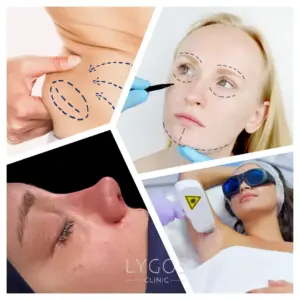Achieve Your Dream Nose with Rhinoplasty!
Rhinoplasty is a procedure that aims to improve the shape, size or function of the nose.
Rhinoplasty Techniques
- Open Rhinoplasty
- Closed Rhinoplasty
- Piezo Rhinoplasty
- Revision Rhinoplasty
- Functional Rhinoplasty
- Tip Rhinoplasty
- Rhinoplasty with Fillers

Before – After Rhinoplasty (Nose Job)




Rhinoplasty Process in Lygos Clinic
Google Reviews LYGOS CLINIC
Contact us for a painless process and great results!
Informations About Rhinoplasty Techniques

Open Rhinoplasty Technique
Open rhinoplasty is a surgical procedure used to reshape the nose by making a small incision on the columella (the tissue between the nostrils). This technique provides surgeons with greater visibility and precision, especially for complex cases. Ideal for correcting structural issues or achieving aesthetic goals, it ensures long-lasting results.
Closed Rhinoplasty Technique
Closed rhinoplasty is a cosmetic procedure to reshape the nose without external incisions. All adjustments are made through the nostrils, resulting in no visible scars and a faster recovery. Ideal for minor corrections, it offers functional and aesthetic improvements while maintaining a natural look and structure.


Piezo Rhinoplasty Technique
Piezo rhinoplasty is a modern technique that uses ultrasonic vibrations to reshape nasal bones precisely and gently. This innovative method minimizes tissue damage, swelling, and bruising, ensuring a quicker recovery. Ideal for patients seeking natural results, piezo rhinoplasty offers improved accuracy and safety compared to traditional approaches.
Frequently Asked Questions About Rhinoplasty Surgery
Look for a board-certified plastic surgeon with extensive experience in rhinoplasty. Check their before-and-after photos and patient reviews to ensure they align with your aesthetic preferences.
The cost of rhinoplasty varies depending on the surgeon’s expertise, geographic location, and the complexity of the procedure. It’s important to consult with a qualified surgeon for a detailed estimate.
Non-surgical rhinoplasty uses dermal fillers to temporarily enhance the shape of the nose without surgery. This method is ideal for minor corrections but does not address structural issues or provide permanent results.
Open rhinoplasty involves an external incision on the columella, providing better visibility for complex cases. Closed rhinoplasty involves internal incisions and is often used for minor corrections with no visible scars.
As with any surgery, rhinoplasty carries risks such as infection, bleeding, scarring, or dissatisfaction with the results. Choosing an experienced and qualified surgeon minimizes these risks.
Initial recovery typically takes 7–10 days, during which swelling and bruising subside. Full results may take up to a year to appear as the nose continues to heal and settle into its new shape.
BLOG

Nose Filler | Non-Surgical Rhinoplasty | LYGOS CLINIC 2025
Nose Filler – Non Surgical Rhinoplasty Nose filler procedure or non-surgical rhinoplasty solutions are a much more cost-effective and accessible

Non-Surgical Rhinoplasty | How to do it | LYGOS CLINIC 2025
Non-Surgical Nose Job: Is It Right for You? As the name suggests, the non-surgical rhinoplasty method is called non-surgical rhinoplasty.

Plastic Surgery Results | Before and After | LYGOS 2025
Before and After: Real Results from Plastic Surgery Plastic Surgery gives people who are uncomfortable with their appearance the look
Special Note:
Our treatments are provided by healthcare facilities that possess a health tourism authorization certificate



